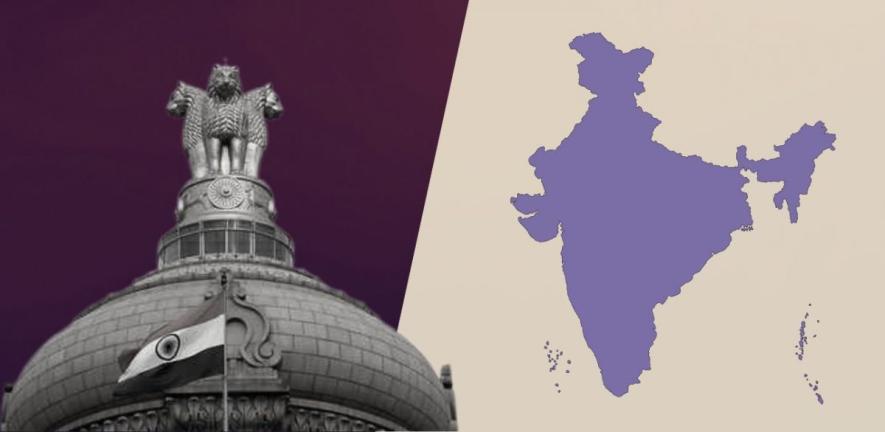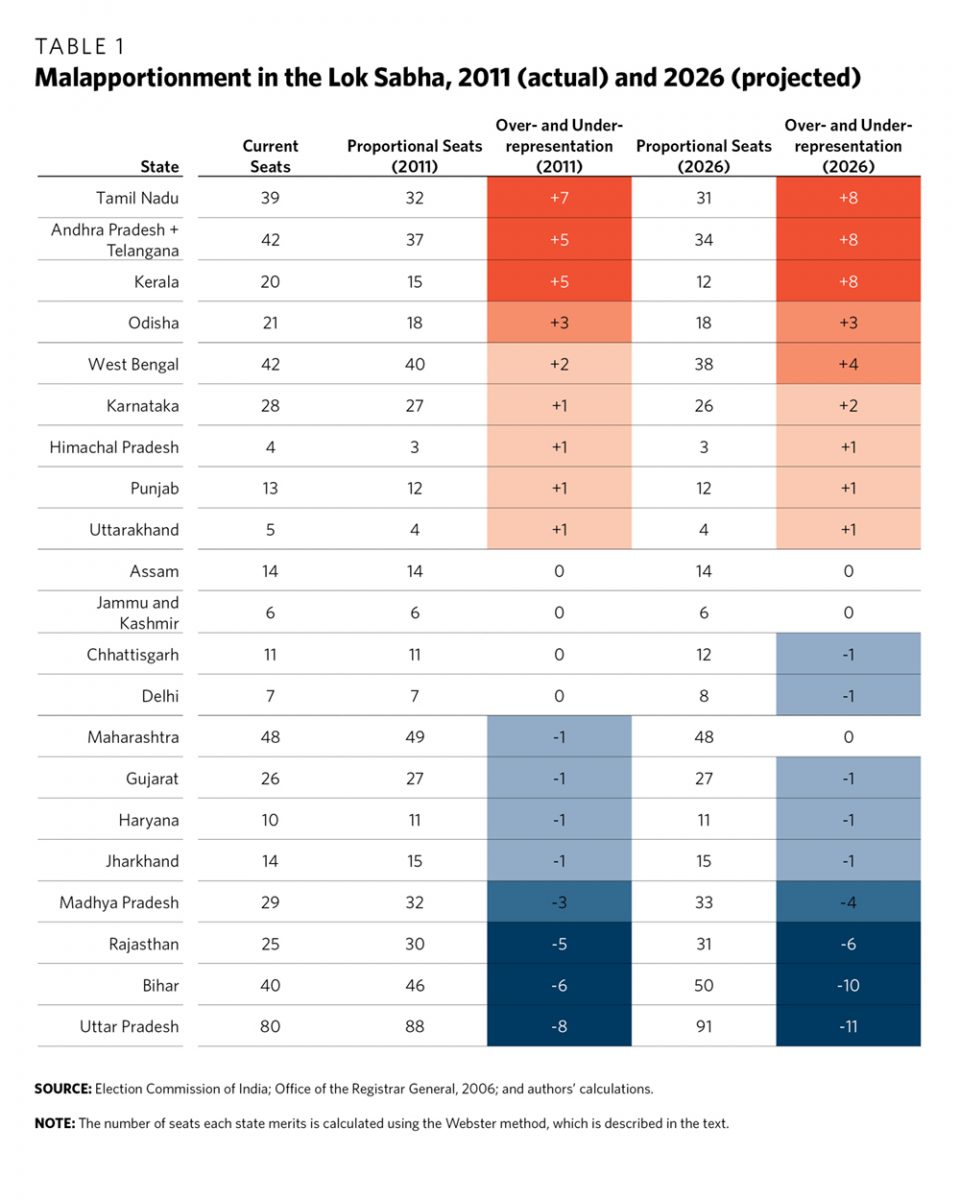The North Versus South Delimitation Challenge to Indian Federalism

Image courtesy: The Leaflet
As India braces itself for the impending general elections, the issue of delimitation of constituencies is surfacing again.
The speculation about delimitation has already been revived since the inauguration of the new Parliament complex, with an expanded seating capacity of 888 members in the Lok Sabha.
The size of electoral constituencies in India was frozen in 1976 with the census data of 1971 as its basis. Meanwhile, the nation’s population has witnessed a manifold increase, coupled with substantial shifts in internal demographics.
Adherence to outdated constituency sizes has given rise to malapportionment, denoting the disparity between electoral constituencies and the population shares within designated geographical units.
For instance, in Bihar, one member of Parliament (MP) represents approximately 3.1 million citizens, while in Kerala, the corresponding ratio stands at 1.75 million.
This ‘crisis of representation’ poses a considerable challenge, primarily stemming from the southern states’ concerns regarding the potential dominance of the northern and Hindi-speaking population.
In states such as Kerala and Tamil Nadu, where the family planning programme has been effectively implemented, there is apprehension about the possible reduction of parliamentary constituencies during the delimitation process.
Consequently, there is a fear of an inequitable allocation of Union funds to states, hindering growth and perpetuating the North–South divide.
India’s constitutional design and history of delimitation
Delimitation means the act of fixing boundaries or limiting the area of the Constitution. The Indian Constitution stipulates proportional representation as the basis for the allocation of seats in the Lok Sabha.
Article 81 mandates that each state be granted seats commensurate with its population and distribute those seats among constituencies of approximately uniform size.
In order to divide the seats proportionally, Article 82 prescribes the reallocation of seats after every decennial census based on updated population figures.
The 42nd amendment to the Constitution, introduced at the time of national emergency, froze the number and boundary of constituencies in Lok Sabha (Article 81) and state legislatures (Article 171) as per the population figures of the 1971 census.
The freeze was initially for a period of 25 years ending in 2001. The apparent reason behind the decision was the disparity in the implementation of family planning efforts. The government wanted to avoid penalisation of states that have successfully limited population growth.
In 2001, when time came to readjust the size of constituencies as per the Constitution, the Vajpayee government, due to a fragile coalition, decided to postpone the reallocation further till 2026.
Since the 2021 census has been postponed because of Covid and is now scheduled to begin in late 2024, there is a possibility that unless further postponed, delimitation across states will change the size of constituencies across the country.
Extent of malapportionment of seats
Malapportionment of seats was already a significant issue in 2001, prior to the delimitation getting postponed to 2026.
Political scientist Alistair McMillan highlighted the severity of the over-representation and under-representation at that time. His estimate, based on the data from the 2001 census, found that Tamil Nadu should have seven fewer Lok Sabha seats while Uttar Pradesh should have gained seven more seats.
Milan Vaishnav’s work on India’s crisis of representation adjusts McMillian’s calculation to incorporate the 2011 census figure, which shows an even more evident scale of disparities.
Using Webster’s formula (a widely accepted and proven method for fair distribution of seats), Vaishnav tries to project the population figures up to 2026 and repeat this calculation, highlighting the seriousness of malapportionment (see Table 1).

Political implications of future delimitation
The first and foremost implication flagged against delimitation is the advantage to the political parties having a stronghold in the northern states which are not as active in the South, such as the Bharatiya Janata Party (BJP).
If the seats in Lok Sabha are increased without reduction in the number of current seats of any state, the total seats would shoot up to 753 from 543, which is highly beneficial to the National Democratic Alliance (NDA) led by the BJP.
For example, in Uttar Pradesh, Bihar, Madhya Pradesh and Rajasthan, a proportional increase in seats will be from 174 to 284 (a 63 percent increase). In the 2019 general elections, NDA won 156 of these 174 seats with a 90 percent winning rate.
This readjustment of seats will lead to NDA receiving 255 seats just from four states, bringing them extremely close to the new majority mark of 377.
Secondly, it is likely to increase political dissatisfaction in the southern states as they will lose seats vis-à-vis their northern counterparts. Southern states are already facing grievances on several issues, including the Finance Commission’s equalisation formula, which reduced their shares in Union taxes from 18 to 16.2 percent.
Further, they are concerned about encroachment in the administrative and linguistic domains through the use of gubernatorial powers by Union government agencies in the state.
Why is delimitation necessary for Indian democracy?
Arguments in favour of delimitation are primarily based on the foundational value of India’s representative democracy.
Currently, Indians are hugely under-represented because the size of constituencies is too large. In India, on average, one MP represents 25 lakh of the population. The original Indian constitution capped the ratio at one MP per 7.5 lakh.
More importantly, the effect of the delay in the re-adjustment of seats is that India, in reality, does not follow the principle of ‘one person, one vote’.
The likelihood of being born in Bihar means that the size of a constituency is about 3.1 million, whereas if the same person is born in Kerala, the value of their vote increases as one MP caters to 1.75 million people only.
Poorer regions of the country tend to have higher fertility rates compared to more prosperous regions. In a developing economy such as India, poorer regions are expected to see a fall in fertility rates later than relatively richer regions which are already witnessing a slowdown.
This means that poorer regions are also more affected by the 1971 freeze and are trapped in the regions having higher malapportionment.
Solutions for Indian federalism
The simplest solution to the problem is adjusting the seats after 2026 based on the latest population figures. Milan Vaishnav argues that postponing the re-apportionment of seats is similar to the ‘not pulling off the band-aid’ strategy.
The longer the re-adjustment issue drags on, the more difficult it will be to pacify the grievances of a state that is going to lose in terms of the number seats.
An alternative suggestion put forth by McMillian is augmenting Lok Sabha’s seat count. This proposal offers two distinct benefits— first, this will alleviate the issue of the high ‘constituency to MP’ ratio.
Second, increasing the size of the legislative body is a more politically viable option than readjusting the sizes across states. This is primarily because representatives from the southern states are likely to resist any plan that involves reducing seats but may be more amenable to the idea of creating additional seats.
According to Milan Vaishnav’s survey, if we go by the 2011 census data, the legislature’s size will increase to 697 seats for a total Lok Sabha size of 718 MPs.
When projected to 2026, Lok Sabha would have to consist of 848 representatives, exceeding the maximum strength of any lower house in a democratic country today.
Since the above solutions are unlikely to address the main concerns of southern states which already have multiple grievances with the Union, it is important to find a solution that is in harmony with the principles of federalism.
One such solution is to reform Rajya Sabha, which is meant to advocate the interests of the states. The Punchi Commission report proposed an equal representation of states in the Rajya Sabha, irrespective of their population, to maintain a balanced federal structure.
However, this proposal will need to reinstate the ‘domicile requirement’ to an extent, which was removed through an amendment in 2003.
The concern of the southern states about delimitation is not about representation, but about fiscal federalism.
When the freeze was introduced during Indira Gandhi’s tenure, the government used to allocate resources as per the needs, and the poorer states with high fertility rates used to obtain a much larger share of the revenue than they generated within the state.
The alternatives to Rajya Sabha’s reform are unlikely to address the principal concern of the southern states, being fiscal centralisation and lesser say of southern states despite their high contributions to the revenue.
A much safer option would be to follow the approach of concessionary federalism. Chanchal Kumar argues that a concessionary approach to federalism views federalism as a system where the Union government makes concessions that reciprocate those received from sub-national and state governments.
Concessionary federalism ensures that if states experience a loss in one aspect, they gain in another, partially offsetting the loss in utility. Given the delimitation, the Centre can offer three concessions to southern states.
First, it should give a free hand to the state governments in southern India for linguistic policy and culture, since these are issues that have high significance in the states.
Second, increasing the divisible pool to include cess and surcharges can also alleviate the grievance about revenue-sharing arrangements. There should be a step-wise increase in the southern states’ share of the divisible pool from the current 41 percent to 50 percent, giving them more financial backing.
Third, the government can reform the Rajya Sabha by introducing a domicile requirement in the House to ensure that the grievances of these states are heard in the parliamentary forum.
Taking a multifaceted approach can balance the concerns of a skewed distribution of funds owning to delimitation.
Conclusion
The issue of delimitation can have broader political repercussions, especially in the southern states.
It is in the best interest of Indian federalism that a prudent and pragmatic approach is adopted towards delimitation as disregard for their concern can further fuel the tension between Union and southern states.
Regardless of the chosen approach, there should be no delay in discussing India’s future representation. It is strongly argued that this conversation should be integral to a broader negotiated federal agreement between the Union government and the states, addressing matters such as taxes, fiscal allocations, migration and interstate inequality.
The author is a third year student at NALSAR Hyderabad. He is keenly interested in public law, humanities, and socio-legal issues. He usually spends his leisure time reading books and poetry, playing various sorts of sports, and binge-watching TV shows and movies.
Get the latest reports & analysis with people's perspective on Protests, movements & deep analytical videos, discussions of the current affairs in your Telegram app. Subscribe to NewsClick's Telegram channel & get Real-Time updates on stories, as they get published on our website.
























